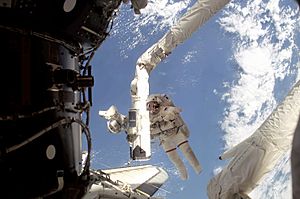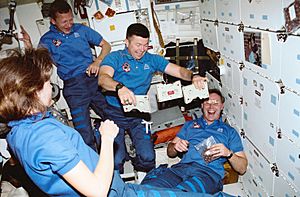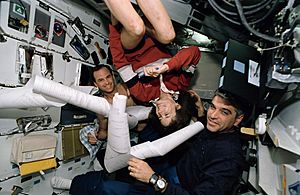Linda M. Godwin facts for kids
Quick facts for kids
Linda Godwin
|
|
|---|---|
 |
|
| Born | July 2, 1952 Cape Girardeau, Missouri, U.S.
|
| Space career | |
| NASA astronaut | |
|
Time in space
|
38d 6h 13m |
| Selection | NASA Group 11 (1985) |
|
Total EVAs
|
2 |
|
Total EVA time
|
10h 14m |
| Missions | STS-37 STS-59 STS-76 STS-108 |
|
Mission insignia
|
|
Linda Maxine Godwin is an amazing American scientist and a former NASA astronaut. She was born on July 2, 1952. Linda Godwin joined NASA in 1980 and became an astronaut in July 1986. She retired from NASA in 2010.
During her time as an astronaut, Linda Godwin flew on four space missions. She spent more than 38 days living and working in space! She also completed two spacewalks, totaling over 10 hours. After leaving NASA, she became a professor at the University of Missouri, teaching physics and astronomy.
Contents
Early Life and Education
Linda Godwin was born in Cape Girardeau, Missouri. Her hometown is Jackson, Missouri. She finished Jackson High School in 1970.
She then went to Southeast Missouri State University. There, she earned a degree in mathematics and physics in 1974. Later, she continued her studies at the University of Missouri. She received a master's degree in physics in 1976 and a doctorate (PhD) in physics in 1980.
Personal Life
Linda Godwin was married to fellow astronaut Steven Nagel. He was even her commander on her first spaceflight! They were married until his passing in 2014.
She is also a member of several groups. These include the American Physical Society and the Association of Space Explorers. She is also a private pilot with an instrument rating. This means she can fly planes using only instruments, even in bad weather.
Joining NASA
Linda Godwin started working at NASA in 1980. She first worked in the Payload Operations Division. This involved helping to prepare and manage the equipment carried on Space Shuttle missions. She also worked as a flight controller. This role meant she helped guide and monitor space missions from the ground.
In June 1985, NASA chose Linda Godwin to become an astronaut candidate. She officially became an astronaut in July 1986. As an astronaut, she worked on many important tasks. She helped test flight software and planned activities for different payloads. She also served as a leader in the Astronaut Office.
Space Missions
Linda Godwin is a veteran of four space flights. She spent over 38 days in space. This includes more than 10 hours during two spacewalks. Her missions were STS-37 in 1991, STS-59 in 1994, STS-76 in 1996, and STS-108 in 2001.
STS-37: Deploying a Giant Telescope
Linda Godwin was a mission specialist on STS-37. The Atlantis launched on April 5, 1991. The main goal of this mission was to deploy the Compton Gamma Ray Observatory (GRO). This was a very heavy telescope designed to study gamma rays from space.
The crew also performed an unplanned spacewalk. They had to fix the GRO's antenna, which was stuck. They also did a planned spacewalk to test how astronauts could move around large structures in space. The mission lasted about 6 days.
STS-59: Studying Earth from Space
Linda Godwin was the payload commander for STS-59. The Endeavour launched on April 9, 1994. This mission was called the Space Radar Laboratory (SRL) mission.
The SRL used special radars to study Earth's surface and atmosphere. These radars helped scientists learn about our planet in new ways. The crew also took over 14,000 photos to help with the research. The mission lasted about 11 days.
STS-76: Visiting the Mir Space Station
Linda Godwin was a mission specialist on STS-76. The Atlantis launched on March 22, 1996. This was the third time a Space Shuttle docked with the Russian space station Mir.
During this mission, an American astronaut transferred to Mir for a five-month stay. The crew also moved thousands of pounds of supplies and equipment to Mir. Linda Godwin performed a six-hour spacewalk. She attached experiment packages to the Mir docking module. These packages helped detect tiny pieces of space debris and contamination. The mission lasted about 9 days.
STS-108: Delivering Supplies to the ISS

Linda Godwin served as a mission specialist on STS-108. The Endeavour launched on December 5, 2001. This was the 12th time a Space Shuttle visited the International Space Station (ISS).
The crew delivered new astronauts to the ISS and brought others back to Earth. They also unloaded over 4,600 pounds of supplies and experiments. Linda Godwin used the Shuttle's robotic arm to move a large module onto the station. She also took part in a spacewalk. During this spacewalk, she helped wrap special blankets around parts of the ISS solar arrays. The mission lasted about 12 days.
See also
 In Spanish: Linda M. Godwin para niños
In Spanish: Linda M. Godwin para niños




